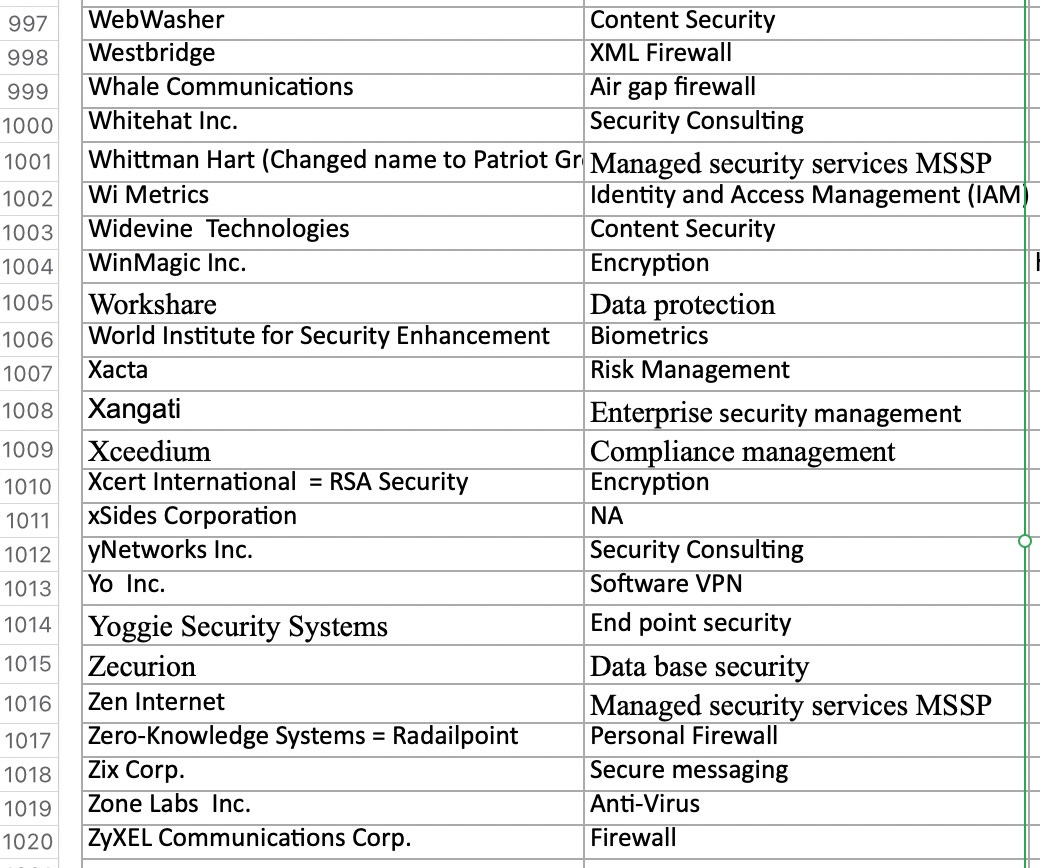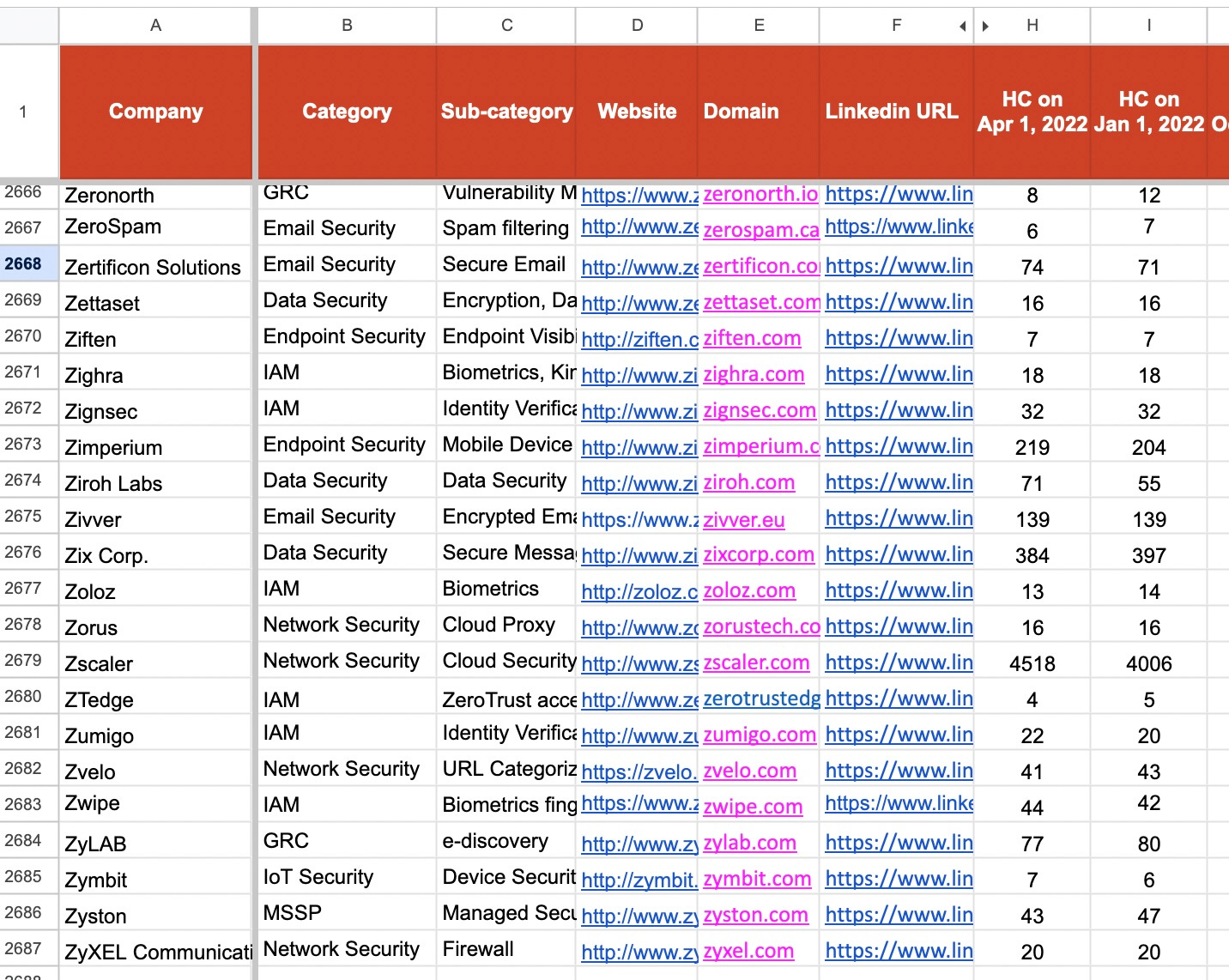The other day I found the original LLC registration for IT-Harvest, dated August 7, 2006. The was shortly after I left Webroot Software. The name was influenced by the annual olive harvest held at Davero Farms in Healdsburg, California. Guests would arrive early on a Saturday in November and pick olives until we sat for lunch. At that time I had been formulating the idea for an analyst firm that would be data-driven, much like DataQuest when it was acquired by Gartner. It seemed like the name fit a company that was harvesting data about IT companies.
We immediately began collecting data on cybersecurity startups. When I began I had a spreadsheet with 600 vendors. I knew there were more than that because I talked to research associates at VCs that claimed to have over 1,000 in their spreadsheets.
We hired WFH researchers in Salt Lake City to collect data for us. We had a master list of vendors and websites and the team would capture their headquarters addresses from their websites. By 2018 the Master list contained 1,020 vendors.
A few of these vendors are still with us. Some seem to be mis-categorized. Xceedium should have been privileged access management, for instance. Note that Zscaler is missing (it was founded that year)! Remember Whale Communications?
In those early days we built a web app and sold subscriptions to it. All of our customers were analyst relations people at big vendors that I had worked with when I was at Gartner. Not a single one ever logged in to the platform. We had to abandon the platform and I took a role at Fortinet.
One of the cool features in the original platform was these maps of vendor locations.
In 2008 I restarted IT-Harvest. 2008 was also the year I decided to write a book. Because we had just seen state actors engaging in “cyber attacks” in Georgia the topic was cyberwar. I traveled to Estonia to research that book, published in 2010 by Government Institutes. Surviving Cyberwar is still available on Amazon for $89 new.
That price, coupled with the academic press, meant the book did not fare well against Dick Clarke’s Cyber War which became a NYT best seller and sold for $6.24. But I was hooked on writing after that and have not stopped.
I was signing copies of Secure Cloud Transformation: The CIO’s Journey at RSAC 2019 when I came up with the idea for what became Security Yearbook 2020: A History and Directory of the IT Security Industry. To create the directory of 2,000+ vendors in the back I had to refresh the list. By then I had discovered the value of tracking headcount for each vendor.
I researched using Amazon’s Mechanical Turk as a way to displace the need for hourly workers in Salt Lake City. I post a trial list of several hundred vendors to the platform. Like most gig sites you cannot communicate directly with the people doing the work. But the workers can reach out to ask questions and one of them did, Sambath Ramesh, who had a team of researchers in India. That same day Amazon suspended all of my accounts because they claimed posting a list of companies and asking for addresses violated the Mechanical Turk terms. In addition to no longer being able to purchase things on Amazon.com, I could not get to my DNS and I could not upload a manuscript to KDP. After several stressful hours and faxing a copy of my driver’s license to a random fax number I got access back. I was not going to risk that again so I reached out to Sambath and asked him to complete the task of gathering information on each vendor. That turned into a partnership that is still ongoing.
By the time we were assembling the Directory for Security Yearbook 2022 the Google Sheet we used had grown to 2,686 records.
.
I had hired our first intern, Maximillian Schweizer, in January of 2022. His first task was to generate the text for the printed directory. I then gave him the job of using bubble and Airtable to create a web app that was “better than a spreadsheet.” Within a week he had created the first version of the Dashboard. Within two months it was better than a spreadsheet and I began using it every day. We launched on March 30, 2022. By May we had our first subscriber.
It’s been a whirlwind since that launch. IT-Harvest quickly transitioned from an independent analyst firm of one to a SaaS startup. Maximillian is CTO and co-founder. We had our own booth at the Gartner Security and Risk Management Summit in DC this June. We gained customers in fourteen countries including the Netherlands, UAE, Saudi Arabia, Romania, UK, and Portugal. The introduction of product data on 10,600+ cybersecurity products has shifted our direction dramatically. From the only platform for researching the cybersecurity industry we have become the only catalog of all cybersecurity products. While VC and private equity firms still come to us, we are rapidly becoming a must-have resource for CISOs, security architects, and their teams.
If you are at BlackHat today drop by Black Kite’s booth at 3 PM where I will be signing copies of Security Yearbook 2024. Or visit the Nucleus booth at 10:30 tomorrow morning. If those times don’t work I will be signing any remaining copies in the Black Kite Booth, again at 3 PM on Thursday.









You have always been many steps ahead Richard. ;)
Congratulations Richard. 🎉🍻
Here’s to many more milestones. What a remarkable journey it’s been for you and IT Harvest.